1879 was a crucial year for the National League. After enduring yet another multiple franchise loss (
With the larger configuration, the schedule was expanded from 60 games to 84, which also allowed NL clubs to be less reliant on exhibitions with non-league teams for revenue. David Nemec cites this season as the one in which playing in the National League gained a special status, a “major league” feel, due largely to these changes.
The playing rules got their customary annual tweak. The Spalding ball, manufactured of course by Al Spalding, became the official league ball. Fouls had to be caught on the fly, rather than on the first bound, and pitchers could now be fined for intentionally hitting batters (although the batter did not yet earn first base for his trouble). The width of the pitcher’s box was reduced from six feet to four, pitchers could not turn their back completely during a delivery, and every bad pitch was called a ball, rather than every third. Since the number of balls needed for a walk went to nine rather than three, this rule did not affect the game, but it brought practice closer to modern standards. The first batter in the next inning was now the next batter in the order who had not completed a plate appearance, rather than the one that followed the last man retired. Finally, batters were now automatically out if the catcher made a clean catch on strike three. This encouraged catchers to play closer to the plate.
The disappointing Chicago White Stockings looked as if they would get redemption; they got off to a 6-0 start and led the race into August. At that point, though, their new manager and star Cap Anson was sidelined by a liver illness, and
The schedule set up perfectly, as the two teams were set to play the final six games of the season head-to-head starting on September 23. The Grays entered the series with a three game lead over the Red Caps, so
Only
STANDINGS
In 1879, the league hit .255/.271/.329 for a .094 SEC, with 5.31 runs and 24.60 outs per game.
George Wright won the pennant in his first (and only) season as a big league manager. The Grays were helped when he brought Jim O’Rourke with him from Beantown; they also added Chicago’s Joe Start, and brought Mike McGeary and Bobby Mathews back into the league after they were absent in 1878. They were the only team in the league to have two good pitchers--
Despite the pennant, attendance in
This was Wright’s only season because as a manager because he would retire at the end of the season to tend to his sporting goods business. While he would pull a Michael Jordan, he was never again the same player
The Red Caps were hurt by the defections of George Wright and Jim O’Rourke to
Once again, Harry Wright was forced to play musical chairs with his infield; this time, Morrill and Sutton moved back to their 1877 positions, with rookie Cogswell manning first base.
The Bisons had a very solid debut season, illustrating historians’ claims that the earliest NL teams were not significantly stronger than the top independent and IA clubs. It is not surprising when considering the fact that the 1878 Bisons beat every team in the National League in exhibition play, with an overall record of 10-7 (Joe Overfield, SABR’s Road Trips). For the second year in a row, John Clapp was the manager for a first year team (he led the Indianapolis Blues in 1878). His team was composed of NL rookies except for himself, Chick Fulmer and Bill Crowley (each former Louisville Grays), Dave Eggler (last with the White Stockings in 1877), and Davy Force, who last played with
Captain Force opposed the Bisons’ move to the NL, and even wrote a letter to team management espousing his position; his main objection was the financial turmoil often present in the NL. One wonders if there was not a tiny bit of self-preservation involved; after all, his offensive production was pretty putrid.
CHICAGO
While the promising season was derailed by Anson’s illness, he earned the respect of the brass including Al Spalding in a way that his predecessor Bob Ferguson could not. According to Bill James in the 1990 Baseball Book, Anson was involved in an argument with an umpire one day when Spalding decided to come onto the field to put his two cents in. Anson shifted his focus and went off on Spalding. When Spalding refused to leave the field, Cap “reminded” the ump that he could forfeit the game. At that point, Spalding left.
His club was bolstered by a wholesale raid of defunct
Unfortunately, top starter Terry Larkin was hit by a line drive and was never the same, only appearing in five games with
The Reds installed Deacon White as manager, replacing Cal McVey. White signed Ross Barnes, out of the NL in 1878, to play shortstop; Will Foley was brought back after one year in
White was removed after sixteen games while the team was on its first east coast trip, and McVey was put back in charge. That did not stop the soap opera, though, as rookie shortstop Mike Burke (who had lost his job to Barnes) fought with McVey in public view on the field after his release. The Reds’ salary structure (McVey, Deacon White, and Barnes all made $2,000 while the other players made $800) was blamed for the dissension by some observers. Joe Gerhardt, one of the better second baseman in the league in 1878, saw his production plummet (+2.1 to -.2 WAR). At the end of the campaign, all players were released and the franchise withdrew from the NL, only to be quickly replaced by another
Also gone from the scene was Cal McVey, who was done in the NL at age 30 despite a solid +1.7 WAR season. McVey moved to
CLEVELAND
According to David Nemec, July 19’s game between
The Stars had a higher W% in the 1878 IA than the Bisons, but
A couple of interesting anecdotes on this team come from Lloyd Johnson and Brenda Ward in the Bill James Encyclopedia program. One is that “Blondie” Purcell was so called because he used peroxide on his hair. The RF/P would wind up in
Regardless of what it was,
The Trojans brought in Bob Ferguson, the White Stockings’ failed skipper of 1878, to manage a team made up largely of players culled from IA teams.
That the team survived is a bit surprising; the other small city NL club,
Interesting to note here is the performance of the two first baseman: 23 year old Aaron Clapp and 21 year old Dan Brouthers, each rookies. Brouthers got 169 PA and Clapp got 152; Brouthers hit for a slightly better average (seven points) and a lot more power (.155 ISO to .103), but Clapp drew more walks and their overall offensive production were essentially the same (111 ARG). Brouthers comes out a bit better in value metrics due to his extra PA. After 1879, their career paths would diverge greatly. Clapp would never again play in the major leagues, and Brouthers…well, we’ll see his exploits in later installments.
Leaders and trailers:
BATTING AVERAGE
1. Paul Hines, PRO (.357)
2. Jim O’Rourke, PRO (.348)
3. King Kelly, CIN (.348)
Trailer: Will White, CIN (.136)
Trailing non-pitcher: Barney Gilligan, CLE (.171)
ON BASE AVERAGE
1. Jim O’Rourke, PRO (.371)
2. Paul Hines, PRO (.369)
3. Charley Jones, BSN (.367)
Trailer: Will White, CIN (.153)
Trailing non-pitcher: Barney Gilligan, CLE (.171)
SLUGGING AVERAGE
1. John O’Rourke, BSN (.521)
2. Charley Jones, BSN (.510)
3. King Kelly, CIN (.493)
Trailer: Will White, CIN (.156)
Trailing non-pitcher: Bill Holbert, SYR (.201)
SECONDARY AVERAGE
1. Charley Jones, BSN (.276)
2. Ed Williamson, CHN (.228)
3. John O’Rourke, BOS (.205)
Trailer: Bill Holbert, SYR (.004)
Holbert’s secondary contributions amounted to just one solitary walk in 245 PA. I believe that this is the lowest Secondary Average of all-time.
RUNS CREATED
1. Paul Hines, PRO (90)
2. Charley Jones, BSN (82)
3. Jim O’Rourke, PRO (79)
4. King Kelly, CIN (76)
5. John O’Rourke, BSN (70)
ARG
1. Charley Jones, BSN (173)
2. John O’Rourke, BSN (171)
3. Paul Hines, PRO (168)
4. Jim O’Rourke, PRO (165)
5. King Kelly, CIN (162)
Trailer: Will White, CIN (21)
Trailing non-pitcher: Barney Gilligan, CLE (51)
WAA
1. Charley Jones, BSN (+3.2)
2. Paul Hines, PRO (+3.2)
3. Jim O’Rourke, PRO (+2.7)
4. John O’Rourke, BSN (+2.7)
5. King Kelly, CIN (+2.5)
Trailer: Will White, CIN (-3.7)
Trailing non-pitcher player: Joe Gerhardt, CIN (-1.8)
WAR
1. Paul Hines, PRO (+4.6)
2. Charley Jones, BSN (+4.5)
3. Jim O’Rourke, PRO (+4.0)
4. King Kelly, CIN (+3.9)
5. Ed Williamson, CHN (+3.8)
Trailer: Will White, CIN (-1.3)
Trailing non-pitcher: Hick Carpenter, SYR (-.7)
I have included pitchers in the trailer lists because, unlike today where you have a five man rotation and pitchers generally only get two or three PAs a game, at this time you had one pitcher, pitching a majority of your games and completing most of those. Pitchers got enough PA to qualify (I have been using 200 as a the minimum), so why not include them? White’s hitting was horrid, and that cost the Reds real games (White had a 21 ARG; the next lowest pitcher was his ex-teammate, Bobby Mitchell of Cleveland, who put up a 36, and did it in 145 less outs.)
ARA
1. Tommy Bond, BSN (62)
2. Monte Ward, PRO (73)
3. Will White, CIN (91)
Trailer: Blondie Purcell, SYR (159)
WAA
1. Tommy Bond, BSN (+6.3)
2. Monte Ward, PRO (+4.7)
3. Will White, CIN (+1.7)
Trailer: Blondie Purcell, SYR (-3.1)
T WAR
1. Monte Ward, PRO (+7.4)
2. Tommy Bond, BOS (+7.4)
3. Pud Galvin, BUF (+2.4)
Trailer: Bobby Mitchell, CLE (-3.0)
My all-star team:
C: Deacon White, CIN
1B: Joe Start, PRO
2B: Chick Fulmer, BUF
3B: King Kelly, CIN/Ed Williamson, CHN
SS: George Wright, PRO
LF: Charley Jones, BSN
CF: Paul Hines, PRO
RF: Jim O’Rourke, PRO
P: Tommy Bond, BSN/Monte Ward, PRO
MVP: CF Paul Hines, PRO/LF Charley Jones, BSN
Rookie Hitter: CF John O’Rourke, BSN
Rookie Pitcher: Pud Galvin, BUF
At second base, Chick Fulmer and Jack Farrell each had 1.9 WAR. Palmer’s FR had Farrell at -14 and Fulmer at +18, making this an easy choice. At third, Kelly was +3.9 WAR and Williamson +3.8; in FR, they were +10 and +18, respectively. If you take the FR as equally reliable to the batting figures, that would make Williamson more valuable; I don’t, but it’s more than enough to make it a tie in my book.
The choice at pitcher between Bond and Ward comes down to the choice between superior pitching and superior hitting. Bond beat Ward in pitching WAA 6.3 to 4.7, but Ward’s hitting would have provided value at any position (57 RC, 109 ARG). In the end, they are close--if you want to view this as a pitching-only honor, than Bond is your man. In terms of overall value, I see it as too close to call.
I also split the baby on the MVP question. Hines’ 4.6 WAR was slightly better than Jones’ 4.5, but remember that all outfielders have been lumped together, with no recognition that Hines played center and Jones played a corner. In Palmer’s FR, Jones was +13 and Hines was +5; but again, Hines’ status as a center fielder can’t be ignored. When dealing with things so far in the past with limited information, I think it’s best to err on the side of caution, and I have done that with these choices.

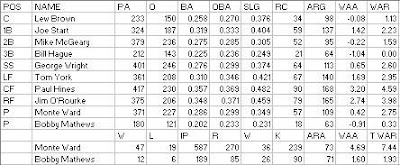
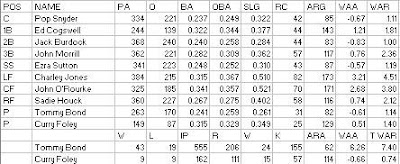

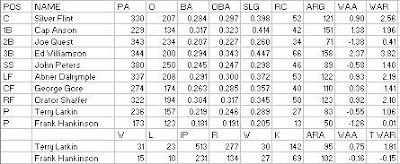
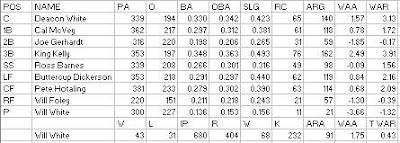
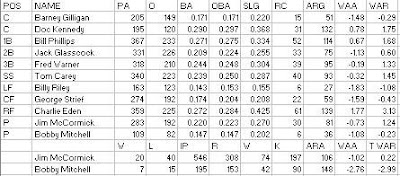
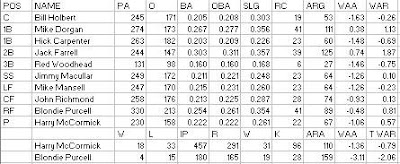
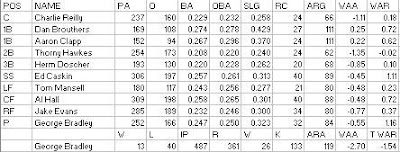
"Only Syracuse left the league at the end of the season, making for the most stable off-season in terms of franchise intrigue yet."
ReplyDeleteOr rather, Syracuse left the league somewhat before the end of the season, due to financial collapse. Off the top of my head, I think this is the last NL team to fail to complete its season, but don't quote me on that.
Syracuse was an interesting club, rising from the amateur ranks and going professional in 1877. They were one of the most active clubs that year, touring extensively (in part because the city of Syracuse wasn't really a large enough market to support them). I think it was a huge mistake for them to join the NL, as it took away their flexibility. They had finessed their schedule the previous two years. In the NL, they couldn't do this nearly so much. It is unlikely, however, that they would have survived much longer anyway. There was a general decline of professional baseball, and by July of 1880 there were only two non-NL clubs in the east.